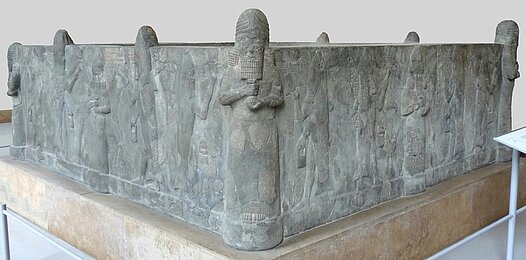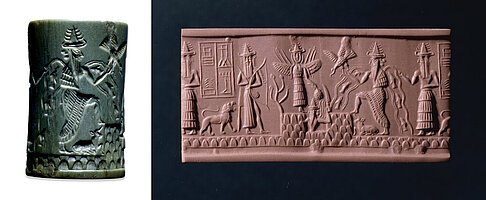Gods & Stars
The magical triad
The main deities invoked in Mesopotamian magic rituals are Enki-Ea, the god of wisdom and exorcism, who resides in the subterranean ocean; Asalluḫi-Marduk, his son, who too is regarded as a god of exorcistic lore; and the Sun-god Utu-Šamaš, the god of justice and light. Some incantations are addressed to all three gods who, in the later tradition, were considered to be the quintessential gods of magic. While Ea and Marduk are characterised as divine exorcists and purification experts, Šamaš acts as the divine judge who frees the patient, brings light into his darkness and favourably revises the divine verdict manifest in the patient’s suffering.
Deities of exorcism & purification
Other deities that occur regularly in the incantations include the incantation goddess Ningirima, who is in charge of the holy water vessel; the purification god Kusu, who is foremost associated with the censer; the divine fire Gibil-Girra, who represents both the destructive and purifying force of fire; and Siriš, the divine beer, “releaser of god and man.”
Astral deities
During nocturnal rituals, the Moon-god, the stars and the deified night can be addressed; also the period of the new moon, a favourable time for the performance of anti-witchcraft rituals, can be personified and invoked in incantations. The opening incantation of the anti-witchcraft ritual Maqlû calls upon “the gods of the night”, i.e., the stars as the manifestations of the great gods, the deified night, that was identified with the healing-goddess Gula, and the personified three watches of the night (Maqlû I 1-3):
I invoke you, gods of the night,
with you I invoke the Night, the veiled bride,
I invoke Dusk, Midnight and Dawn!
Often purificatory water is left outside under the stars overnight and thus exposed to the power of the astral deities. Many rituals are designed to be performed before specific stars such as Jupiter, Scorpius, Ursa Major or Sirius. The Goat star (Lyra) is, just as the deified night, associated with the goddess Gula and plays a special role in magic rituals.
Witchcraft and the gods
Not only rituals of the exorcist could be performed before the stars. Evil rituals were thought to be performed before the same stars by witches, and some texts indicate that at least certain forms of witchcraft were assumed to have been performed before the very same gods that the ritual client invoked in order to be freed of witchcraft.
The gods and the patient
The gods were not by their very nature allies of the patient. They could have rendered a wrong verdict against him because witches had slandered him; they could have averted their favour in anger because of his own failures. One of the functions of a therapeutic ritual was therefore to convince the invoked gods of the patient’s innocence and to make them change their mind with regard to the patient.
There is also evidence in anti-witchcraft incantations for the idea that the witch performed her witchcraft without the gods’ knowledge and was able to harm the patient by circumventing the attention of the gods. The anti-witchcraft ritual raises the gods’ awareness of the unjustified suffering of the patient and the evil deeds of the witch so the gods redress the situation.
Witchcraft and divine anger are not the only areas of Mesopotamian magic where the gods played an ambivalent role. The abode of Enki-Ea, the subterranean ocean (apsû), was not only the source of incantations and purification rites, but was also considered a place from which demons, diseases and witchcraft had emerged.
© Daniel Schwemer 2014 (CC BY-NC-ND license)







